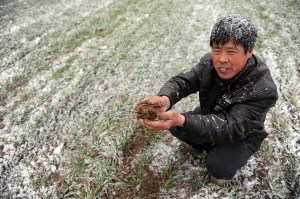 China is a nation of superlatives, and its role in weather manipulation is no exception. Beijing runs the world’s largest program in cloud seeding – the process of imbuing clouds with silver iodide to generate precipitation, usually in times of drought. China rolled out its cloud seeding technology to clear the skies of dust and pollution before the Beijing Olympics; last week, the rocket launchers and aircraft were mobilized again – this time to battle a drought in the nation’s wheat belt.
China is a nation of superlatives, and its role in weather manipulation is no exception. Beijing runs the world’s largest program in cloud seeding – the process of imbuing clouds with silver iodide to generate precipitation, usually in times of drought. China rolled out its cloud seeding technology to clear the skies of dust and pollution before the Beijing Olympics; last week, the rocket launchers and aircraft were mobilized again – this time to battle a drought in the nation’s wheat belt.
Evidently, the world’s biggest cloud seeding program just got bigger. Yesterday, China’s meteorological agency announced that it had received over $1 million from the Ministry of Finance to improve its anti-drought work in rainmaking. Though Beijing’s enthusiasm for the technology has been known to go astray, last week’s efforts are credited with bringing at least some new snow and moisture to parts of the dessicated region.
For many around the world nervously watching China’s wheat crop, that’s good news. As the world’s largest wheat producer, China is self-sufficient in wheat, but if this year’s harvests don’t deliver, there is a possibility that Beijing could burn through its significant reserves and have to start importing wheat, driving global prices up even further. (Yesterday, pushed up by floods in Australia and an earlier drought in Russia, wheat prices reached their highest mark since the 2008 record prices.)
How seriously the possibility of large-scale imports in China should be taken has been the subject of much debate in the last few days. Last week, the United Nation’s Food and Agriculture Organization (FAO) released a report (the first of its kind on China in 15 years) that the drought in the north, which has been going strong since fall, has affected about up to 60% of the nation’s wheat crop. The report reads:
According to official estimates some 5.16 million hectares out of the total of about 14 million hectares under winter wheat may have been affected in these provinces. The drought has reportedly affected some 2.57 million people and 2.79 million livestock due to the shortages of drinking water.
It goes on to say that domestic wheat prices are up 16% over last year, and if the dry weather persists through the spring to affect the next harvest late this year, it could seriously impact global wheat prices.
Chinese officials predictably downplayed the report, estimating that the drought-affected area is closer to 40% — not 60 — and rightly underscoring the fact that the FAO report still predicts that China’s wheat output would remain steady at 112 million tons. The FT’s Javier Blas also called the UN body alarmist for jumping the gun at a sensitive time: “As the FAO tries to pick up the ball – under huge pressure from the French presidency of the G20 to improve its crop forecasting – it risks creating problems. With global agricultural markets on edge, the world is looking at the FAO for guidance. It needs timely and accurate information, but also nuance and perspective.”
Though trying to stamp out any sense of panic, Beijing itself has not exactly been blasé about the current state of affairs. China’s winter wheat crop, harvested in June, yields over 90% of the nation’s supply. Over the weekend, China’s own drought control agency posted that continuing conditions were “grim” and called for emergency irrigation measures in the wheat belt, according to the New York Times. In addition to its hefty new cloud seeding investment, the government also handed out subsidies this fall to help farmers improve irrigation ditches and reservoirs in the wheat belt. A report from state-run daily Xinhua notes today that if all else fails and no rain comes through this winter or spring, “thousands” of wells could supply water.
Which sounds like a lot, but in the land of superlatives, it ain’t. Nor will it be very comforting for the wheat farmers — or the global markets — if the weather doesn’t break before the next planting this summer. So let’s hope for rain.


